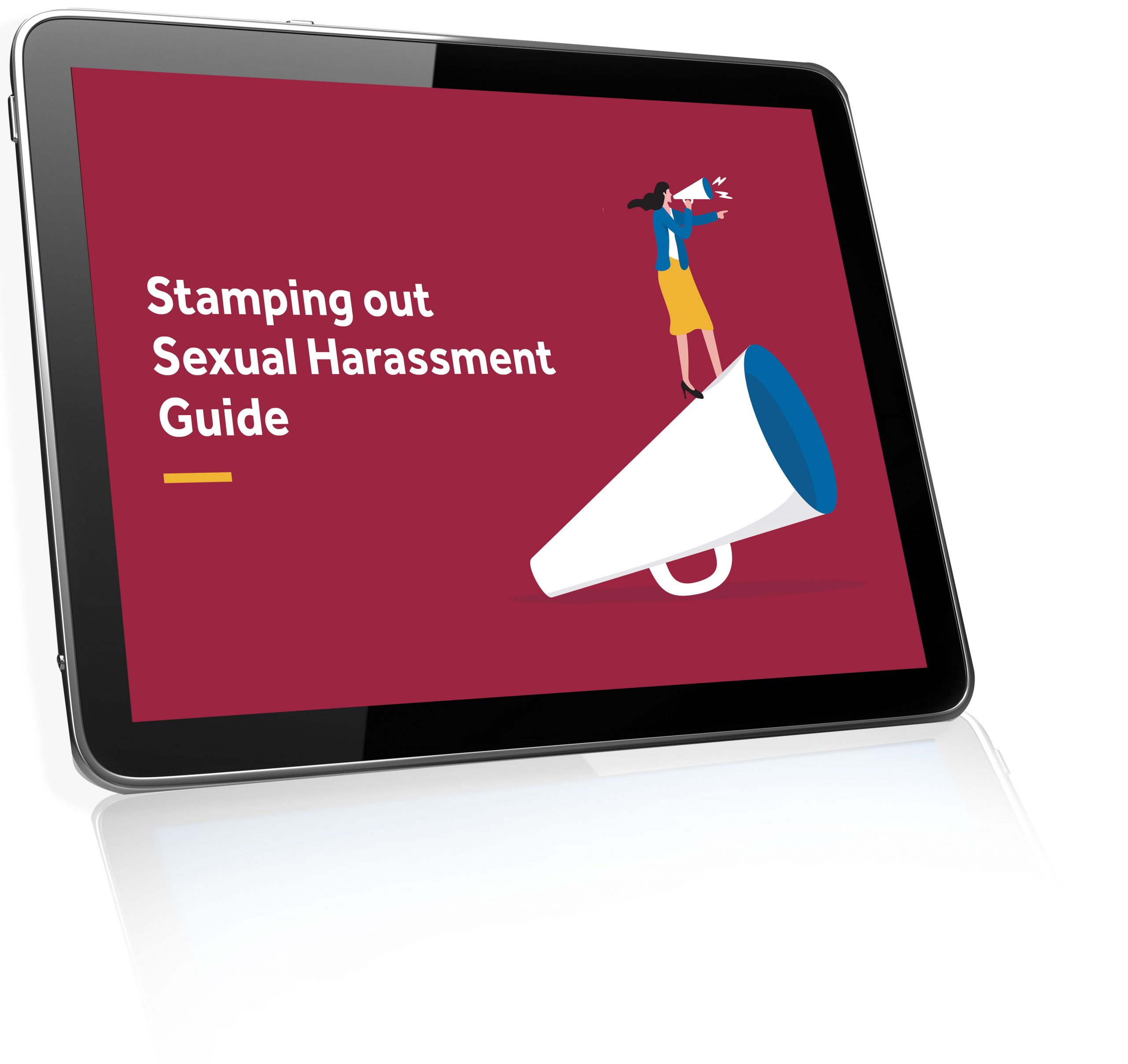
Workplace harassment
Bullying and harassment may seem similar but the legal approach to each one is different. As an employer, it’s crucial to make sure you know how to handle each one.
Harassment is any kind of behaviour that undermines someone’s dignity and is unacceptable or humiliating to them. Unlike bullying, harassment is discriminatory and targets someone because of their age, gender, sexual orientation, marital status, race, disability or ethnicity. It can occur in a series of repeated events, or as a one-off incident.
Sexual harassment
Sexual harassment is where there is unwanted and unwelcome attention of a sexual nature. This may be physical or verbal. It includes indecent assault, deliberate physical contact, or the display of pornographic material. It also includes offensive language, provocative suggestions, or unwelcome phone calls or emails. It is up to the victim to decide whether the behaviour they experience is an act of sexual harassment.
Sexual harassment in the workplace
All workers have the right to a work environment that is safe and free from sexual harassment. Employees, potential employees, and employers are all protected from sexual harassment in the workplace and connected to work.
Sexual harassment is defined as:
An unwelcome sexual advance or request for sexual favours.
Any other form of unwelcome conduct of a sexual nature.
What constitutes sexual harassment?
For behaviour to be interpreted as sexual harassment, it has to be reasonable to expect that there is a possibility that the person harassed would be offended, humiliated or intimidated by the actions of the harasser.
This means that whether behaviour is considered sexual harassment depends on how a reasonable person would interpret the events of the situation.
When working out whether conduct is sexual harassment, the intention of the alleged harasser doesn’t matter – all that counts is the nature of their actions and behaviour.
Sexual harassment doesn’t have to be repeated or continuous and can take the form of a one-off incident. Sexual harassment in the course of employment can be considered serious misconduct, constituting a valid reason for dismissal, and in some cases, a criminal offence that either the employer or harassed employee may decide to report to the police.
Examples of workplace sexual harassment
A wide range of inappropriate workplace behaviour can be deemed as sexual harassment. Examples include:
Physical contact, such as unwelcome touching.
Intentionally brushing against other workers.
Staring or leering at another worker.
A sexually suggestive comment or joke.
A sexually explicit picture or poster.
An unwanted invitation to go out on a date.
A request for sex.
Intrusive questioning about another worker’s sex life or body.
An insult or a taunt that is sexual in nature.
A sexually explicit email or text message.

Dealing with sexual harassment in your business?
Download this FREE Guide for tips, tools, and advice on how to deal with sexual harassment in the workplace.
Is sexual harassment a criminal offence?
According to Australian law, sexual harassment is defined as any unwanted sexual behaviour where a reasonable person would have anticipated the possibility that the person harassed would feel offended, humiliated or intimidated. It has nothing to do with mutual attraction or consensual behaviour.
Under the Sex Discrimination Act, Sexual harassment is unlawful in different areas of public life, including employment, and can constitute a punishable criminal offence.
Protection from sexual harassment in the workplace
As well as act perpetrated by individuals, sexual harassment can happen when a work environment or culture is sexually charged or ‘hostile’, even if the conduct is not directed at any particular employee.
A person who sexually harasses someone else is primarily responsible for their own behaviour. However, in some cases employers can also be held responsible for sexual harassment by their employees. This is called ‘vicarious liability’.
In many situations, vicarious liability applies unless the employer can prove they took all reasonable steps to prevent sexual harassment.
Protections under the Fair Work Act (2009)
Under the Fair Work Act (2009), a person or company may be liable for sexual harassment committed by an employee or agent working in connection with their business.
Fair Work Act laws protect certain workers in Australia, including future workers. A range of people connected to a business or organisation are covered, including:
Employees
Potential employees
Employers and business owners
Contractors and subcontractors
Outworkers
Apprentices and trainees
Interns
Work experience students
Volunteers
As well as the Fair Work Act, there are protections against sexual harassment under other Australian laws.
Secure Jobs, Better Pay reforms
As part of a package of industrial reforms called Secure Jobs, Better Pay, new provisions for sexual harassment came into effect on 6 March 2023.
The Fair Work Act has been amended to prohibit work-related sexual harassment in relation to a broader scope of people.
The revised protection applies to:
Workers including employees, contractors, work experience students and volunteers.
Future workers (candidates interviewing or on trial periods).
People conducting or undertaking a business.
Keep in mind that this protection won’t apply to sexual harassment cases that occurred before 6 March 2023.
According to this legislation, a person, business or organisation can be liable for sexual harassment conducted by an employee or agent unless they can prove that they took all reasonable steps to prevent sexual harassment.
New Fair Work Commission powers
The amendments to the Fair Work Act also mean the Commission now has greater powers to deal with workplace sexual harassment.
In addition to its existing ‘stop sexual harassment order’ powers, the Commission can deal with disputes about sexual harassment by:
Conciliation.
Mediation.
making a recommendation or expressing an opinion.
Where a dispute can’t be resolved through these methods, the Commission may also be able to deal with the dispute by arbitration (if all the parties agree). If this happens, the Commission can make an order:
For compensation and lost wages.
Requiring a person, business or organisation to do something reasonable to remedy any loss or damage suffered.
Applications to the Commission can be made by:
A person or group of people alleging sexual harassment (such as a worker or group of workers).
An industrial association, such as a union, on behalf of a member.
Racial harassment
Racial harassment is any unwanted or hurtful behaviour, whether deliberate or not, based on race, colour, ethnicity, national origin or immigrant status. This may be physical or verbal. It includes verbal abuse, derogatory comments and exclusion from normal work events. It also includes physical attack, racist graffiti or inciting others to perform harassing activities.
Much like cases of sexual harassment, the victim decides what racial harassment is for them.
Examples of racial harassment include:
Making offensive remarks about a person’s race.
Copying or making fun of the way a person speaks.
Making jokes about a person’s race.
Calling people racist names.
Deliberately mispronouncing or mocking people’s names.
An employer’s responsibility to take reasonable steps to prevent racial harassment is set out in federal and state anti-discrimination laws, as well as the Fair Work Act. Collectively, this legislation clearly defines racial harassment as an infringement of workplace laws.
Making a workplace harassment complaint
There are a few ways for a person who has been harassed in the workplace to make a complaint. These include:
Reporting the incident to their managers and seniors.
Applying to the Fair Work Commission.
Lodging a complaint with another government body, such as the Australian Human Rights Commission.
As mentioned above, some forms of harassment could constitute a criminal offence and should be reported to the police.
Managing harassment
Business owners can take reasonable steps to prevent workplace harassment by:
Creating a safe physical and online working environment.
Providing information, instruction, training and support about the importance of preventing sexual harassment in the workplace.
Practicing early intervention and quickly stopping any offensive behaviour.
Encouraging employees to report cases of sexual harassment.
Setting a clear policy
Most importantly, you need to have a clear policy to protect your employees from any type of bullying or harassment at work. It should set out how employees can have their complaints resolved and ideally, help to stop the employment relationship from breaking down.
Anti-discrimination laws, health and safety laws, and bullying laws are different and constantly changing, so you need to stay up to date.
Behaviour that isn’t sexual harassment might still be considered bullying or discrimination in the workplace. It could also breach anti-discrimination or workplace health & safety laws.
Employsure advisers have years of experience dealing with harassment in the workplace, helping thousands of business owners through the trickiest situations. For peace of mind, please call our FREE Advice Line now on 1300 651 415.










